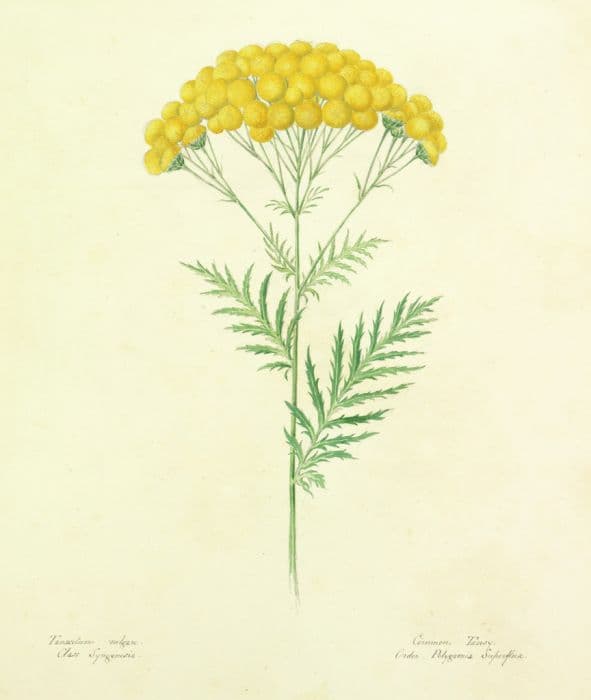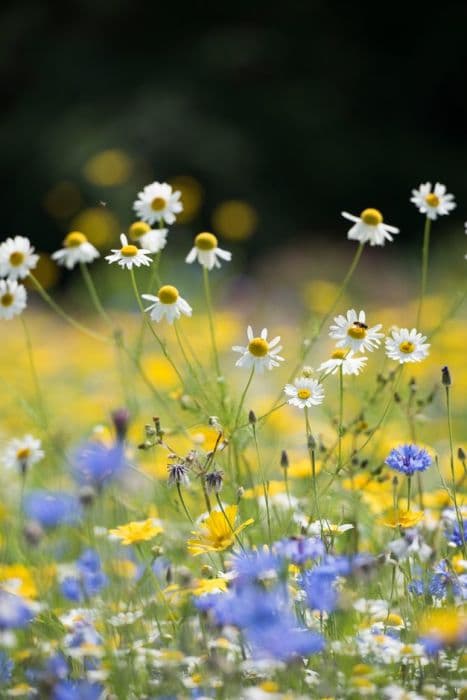Tansy Tanacetum vulgare

ABOUT
The plant known as tansy has a distinctive look that is recognized by its feathery, fern-like foliage and bright yellow, button-like flowers. The leaves are deeply divided and resemble those of a fern in their intricate texture, giving them a delicate appearance. The foliage is typically a vibrant green color, contributing to the plant's overall lush appearance. The flowers are grouped in clusters that form flat-topped arrays that give a showy display when in bloom. The color of the flowers is a bold yellow, which contrasts nicely against the green leaves. These flower heads are comprised of many small, disk-shaped flowers that lack the petals you might find on more familiar flowering plants, creating a somewhat unusual yet attractive floral show. The entire plant exudes a strong, aromatic scent that can be quite potent when the leaves are crushed or brushed against. The distinctive qualities of the tansy, with its ferny leaves and vibrant yellow floral clusters, make it a notable and easily identifiable presence in the areas where it grows.
About this plant
 Names
NamesFamily
Asteraceae.
Synonyms
Common Tansy, Bitter Buttons, Cow Bitter, Mugwort, Golden Buttons.
Common names
Chrysanthemum vulgare, Pyrethrum vulgare, Tanacetum boreale, Tanacetum uliginosum.
 Toxicity
ToxicityTo humans
Tansy (Tanacetum vulgare) contains toxic compounds that can be harmful to humans if ingested. This plant has a high concentration of thujone, a substance that can be poisonous. Symptoms of tansy poisoning may include nausea, vomiting, diarrhea, abdominal pain, restlessness, dizziness, tremors, seizures, and heart or liver complications. In severe cases, ingestion can lead to organ failure or death. Pregnant women should especially avoid tansy as it can stimulate uterine contractions and potentially cause miscarriage.
To pets
Tansy (Tanacetum vulgare) is also toxic to pets. The plant contains several compounds that can cause adverse health effects in animals, including thujone. Symptoms of tansy poisoning in pets may include vomiting, diarrhea, weakness, incoordination, skin irritation, tremors, seizures, and potentially liver damage. In severe cases, consuming tansy can lead to death. Pets should be prevented from ingesting any part of the plant to avoid these toxic effects.
 Characteristics
CharacteristicsLife cycle
Perennials
Foliage type
Deciduous
Color of leaves
Green
Flower color
Yellow
Height
2-3 feet (0.6-0.9 meters)
Spread
2 feet (0.6 meters)
Plant type
Herb
Hardiness zones
2-8
Native area
Europe
Benefits
 General Benefits
General Benefits- Attracts beneficial insects: Tansy, the common name for Tanacetum vulgare, is known to attract predatory wasps and ladybugs that help control garden pests.
- Garden companion plant: Tansy can be planted alongside crops like potatoes to repel certain insect pests, improving overall yield.
- Traditional dye: Historically, Tansy has been used to produce a green dye for textiles.
- Culinary uses: Leaves and flowers have been used as flavoring in certain traditional recipes, although they should be used with caution due to potential toxicity.
- Natural preservative: The herb has been used to help preserve meats and other food products.
- Ornamental plant: With its bright yellow flowers, Tansy can add aesthetics to gardens and attract pollinators during its blooming season.
- In folklore, it has been used to ward off evil spirits and was commonly planted near gravesites and homes for this purpose.
 Medical Properties
Medical Properties- Anthelmintic: Tansy has historically been used to help expel parasitic worms from the body.
- Anti-inflammatory: Components of tansy may have inflammation-reducing properties.
- Antiparasitic: Tansy has been used traditionally to treat scabies and other parasites.
- Antispasmodic: The plant may relieve muscle spasms or cramps.
- Bactericide and Fungicide: Tansy has been used to inhibit bacterial and fungal growth.
- Carminative: It has been used to relieve flatulence and bloating.
- Emmenagogue: Tansy has been used historically to induce menstrual flow.
 Air-purifying Qualities
Air-purifying QualitiesThis plant is not specifically known for air purifying qualities.
 Other Uses
Other Uses- Tansy can be used as a natural insect repellent when its leaves are hung in doorways or windows, as its strong scent is disliked by many pests.
- The plant has been traditionally used to dye fabrics and wool, imparting a yellow or greenish color.
- In the garden, tansy can function as a companion plant, helping to protect other plants from harmful insects due to its repelling properties.
- Historically, tansy was used for embalming purposes because of its preservative qualities and its ability to repel insects.
- The strong scent of tansy has been used in potpourris and floral arrangements to add a distinctive aroma.
- Tansy leaves have been used as a flavoring agent for certain traditional culinary dishes, although caution is advised due to potential toxicity.
- The plant's essential oil is sometimes used in perfumery as a component of certain aromatic products.
- Farmers have used dried tansy in barns and animal bedding to deter pests and parasites from livestock.
- In some cultures, tansy has been used as part of rituals and ceremonies, either for its supposed spiritual properties or as a decorative element.
- Some artists have utilized tansy's natural coloring properties in eco-printing techniques to transfer the shapes and colors of its leaves to paper or fabric.
Interesting Facts
 Feng Shui
Feng ShuiTansy is not used in Feng Shui practice.
 Zodiac Sign Compitability
Zodiac Sign CompitabilityTansy is not used in astrology practice.
 Plant Symbolism
Plant Symbolism- Protection: Tanacetum vulgare, commonly known as tansy, has historically been used to repel insects and worms; hence, it symbolizes protection against pests and negative influences.
- Health: Tansy has been used in traditional medicine for various ailments, implying a symbolic meaning related to health and healing.
- Immortality: Due to its preservative properties and its use in embalming, tansy is associated with immortality and everlasting life.
- Hostility: Tansy's strong, overpowering scent and volatile oils that can be toxic confer a symbolism of hostility or resistance.
 Water
WaterTansy, the common name for Tanacetum vulgare, prefers moderately moist soil and should be watered thoroughly once the top inch of soil feels dry to the touch. During active growth in the spring and summer, this usually means watering once every week with approximately one to two gallons of water per plant to ensure even moisture. In the fall and winter, reduce the frequency as the plant goes dormant or grows more slowly, but do not let the soil completely dry out. Overwatering can lead to root rot, so it's important to ensure good drainage.
 Light
LightTansy thrives best in full sun to part shade. The ideal spot for this plant would be an area that receives at least six hours of direct sunlight daily. However, it can also tolerate some light shade, especially in the afternoon during the hottest part of the day. Avoid deep shade as it can lead to poor growth and fewer flowers.
 Temperature
TemperatureTansy is a hardy plant that can withstand a wide range of temperatures. It can survive minimum temperatures down to about -30 degrees Fahrenheit, making it suitable for many temperate climates. The ideal temperature range for tansy is between 60 and 75 degrees Fahrenheit. It is tolerant of both high and low temperatures, but growth may slow significantly during extreme heat or cold.
 Pruning
PruningTansy should be pruned to remove spent flowers and maintain its shape. This will encourage bushier growth and more blooms. Pruning is best done in late winter or early spring before new growth begins. It's also beneficial to cut back tansy in the fall to tidy up the plant and remove any old or dead stems.
 Cleaning
CleaningAs needed
 Soil
SoilTansy thrives in well-drained loamy soil with a pH ranging from 5.5 to 7.5. Mix garden soil with compost and a bit of sand for improved drainage. Adjust pH as needed before planting.
 Repotting
RepottingTansy plants do not require frequent repotting and can thrive outdoors with minimal disturbance. Repot only if the plant outgrows its container, typically every 2 to 3 years.
 Humidity & Misting
Humidity & MistingTansy is tolerant of a wide range of humidity conditions and does not require any special humidity adjustments.
 Suitable locations
Suitable locationsIndoor
Place in a sunny spot and water moderately.
Outdoor
Full sun, occasional watering, well-drained soil.
Hardiness zone
3-9 USDA
 Life cycle
Life cycleCommonly known as Common Tansy, Tanacetum vulgare is a perennial herb that begins its life cycle as a seed, dispersing from the parent plant when ripe, often in the autumn. Upon finding suitable soil, the seed germinates in the spring, often requiring a period of cold stratification to break dormancy. The seedling emerges and develops into a rosette of leaves at the ground level, relying on energy reserves in the seed until it can photosynthesize. As it matures, the plant develops a sturdy stem and a foliage of deeply-divided, aromatic leaves; during this vegetative state, it establishes a strong root system. Eventually, usually in the second year and every summer thereafter, Tansy produces clusters of yellow, button-like flowers at the top of its stem, which are pollinated by insects. After flowering, the plant generates seeds which complete the life cycle, and the plant may die back to the root in winter, to regrow in the spring.
 Propogation
PropogationPropogation time
Spring-Early Summer
Tansy (Tanacetum vulgare) is commonly propagated through division, which is a straightforward way to create new plants. This method is best performed in the spring as new growth emerges or in the fall when plants are dormant. To propagate tansy by division, carefully dig up an established plant and use a sharp spade or knife to divide the root mass into several sections, ensuring that each new piece has a portion of the root system and several shoots. Replant the divisions promptly, spacing them about 12 to 18 inches (roughly 30 to 45 centimeters) apart to allow for adequate growth. Water the new divisions well to help establish them. This method leverages the plant's natural clumping growth habit, making it an efficient and popular choice for gardeners looking to expand their tansy collection.









![Gerbera [Everlast Pink]](/_next/image?url=https%3A%2F%2Fplants-admin.emdemapps.com%2Fimages%2Fplants%2F%2Fimages%2F604b645d56545.png&w=640&q=75)